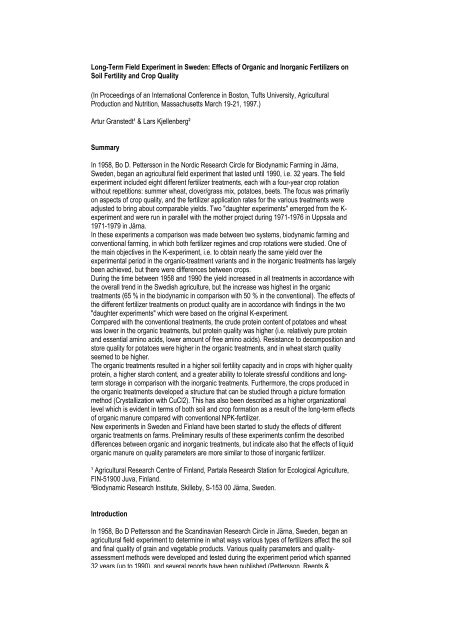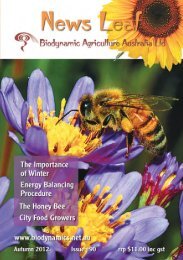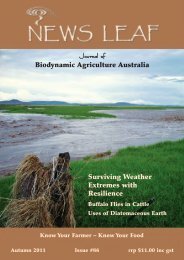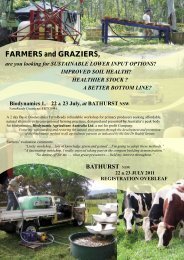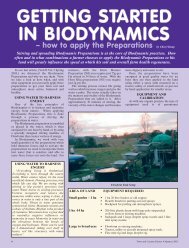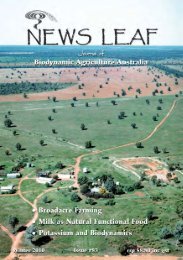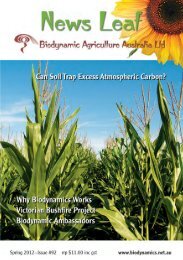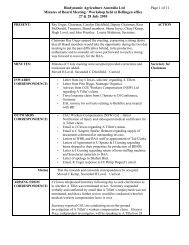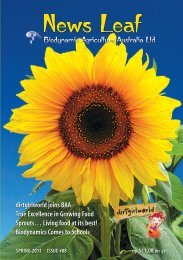Long-Term Field Experiment in Sweden - Biodynamic Agriculture ...
Long-Term Field Experiment in Sweden - Biodynamic Agriculture ...
Long-Term Field Experiment in Sweden - Biodynamic Agriculture ...
You also want an ePaper? Increase the reach of your titles
YUMPU automatically turns print PDFs into web optimized ePapers that Google loves.
<strong>Long</strong>-<strong>Term</strong> <strong>Field</strong> <strong>Experiment</strong> <strong>in</strong> <strong>Sweden</strong>: Effects of Organic and Inorganic Fertilizers onSoil Fertility and Crop Quality(In Proceed<strong>in</strong>gs of an International Conference <strong>in</strong> Boston, Tufts University, AgriculturalProduction and Nutrition, Massachusetts March 19-21, 1997.)Artur Granstedt¹ & Lars Kjellenberg²SummaryIn 1958, Bo D. Pettersson <strong>in</strong> the Nordic Research Circle for <strong>Biodynamic</strong> Farm<strong>in</strong>g <strong>in</strong> Järna,<strong>Sweden</strong>, began an agricultural field experiment that lasted until 1990, i.e. 32 years. The fieldexperiment <strong>in</strong>cluded eight different fertilizer treatments, each with a four-year crop rotationwithout repetitions: summer wheat, clover/grass mix, potatoes, beets. The focus was primarilyon aspects of crop quality, and the fertilizer application rates for the various treatments wereadjusted to br<strong>in</strong>g about comparable yields. Two "daughter experiments" emerged from the K-experiment and were run <strong>in</strong> parallel with the mother project dur<strong>in</strong>g 1971-1976 <strong>in</strong> Uppsala and1971-1979 <strong>in</strong> Järna.In these experiments a comparison was made between two systems, biodynamic farm<strong>in</strong>g andconventional farm<strong>in</strong>g, <strong>in</strong> which both fertilizer regimes and crop rotations were studied. One ofthe ma<strong>in</strong> objectives <strong>in</strong> the K-experiment, i.e. to obta<strong>in</strong> nearly the same yield over theexperimental period <strong>in</strong> the organic-treatment variants and <strong>in</strong> the <strong>in</strong>organic treatments has largelybeen achieved, but there were differences between crops.Dur<strong>in</strong>g the time between 1958 and 1990 the yield <strong>in</strong>creased <strong>in</strong> all treatments <strong>in</strong> accordance withthe overall trend <strong>in</strong> the Swedish agriculture, but the <strong>in</strong>crease was highest <strong>in</strong> the organictreatments (65 % <strong>in</strong> the biodynamic <strong>in</strong> comparison with 50 % <strong>in</strong> the conventional). The effects ofthe different fertilizer treatments on product quality are <strong>in</strong> accordance with f<strong>in</strong>d<strong>in</strong>gs <strong>in</strong> the two"daughter experiments" which were based on the orig<strong>in</strong>al K-experiment.Compared with the conventional treatments, the crude prote<strong>in</strong> content of potatoes and wheatwas lower <strong>in</strong> the organic treatments, but prote<strong>in</strong> quality was higher (i.e. relatively pure prote<strong>in</strong>and essential am<strong>in</strong>o acids, lower amount of free am<strong>in</strong>o acids). Resistance to decomposition andstore quality for potatoes were higher <strong>in</strong> the organic treatments, and <strong>in</strong> wheat starch qualityseemed to be higher.The organic treatments resulted <strong>in</strong> a higher soil fertility capacity and <strong>in</strong> crops with higher qualityprote<strong>in</strong>, a higher starch content, and a greater ability to tolerate stressful conditions and longtermstorage <strong>in</strong> comparison with the <strong>in</strong>organic treatments. Furthermore, the crops produced <strong>in</strong>the organic treatments developed a structure that can be studied through a picture formationmethod (Crystallization with CuCl2). This has also been described as a higher organizationallevel which is evident <strong>in</strong> terms of both soil and crop formation as a result of the long-term effectsof organic manure compared with conventional NPK-fertilizer.New experiments <strong>in</strong> <strong>Sweden</strong> and F<strong>in</strong>land have been started to study the effects of differentorganic treatments on farms. Prelim<strong>in</strong>ary results of these experiments confirm the describeddifferences between organic and <strong>in</strong>organic treatments, but <strong>in</strong>dicate also that the effects of liquidorganic manure on quality parameters are more similar to those of <strong>in</strong>organic fertilizer.¹ Agricultural Research Centre of F<strong>in</strong>land, Partala Research Station for Ecological <strong>Agriculture</strong>,FIN-51900 Juva, F<strong>in</strong>land.²<strong>Biodynamic</strong> Research Institute, Skilleby, S-153 00 Järna, <strong>Sweden</strong>.IntroductionIn 1958, Bo D Pettersson and the Scand<strong>in</strong>avian Research Circle <strong>in</strong> Järna, <strong>Sweden</strong>, began anagricultural field experiment to determ<strong>in</strong>e <strong>in</strong> what ways various types of fertilizers affect the soiland f<strong>in</strong>al quality of gra<strong>in</strong> and vegetable products. Various quality parameters and qualityassessmentmethods were developed and tested dur<strong>in</strong>g the experiment period which spanned32 years (up to 1990), and several reports have been published (Pettersson, Reents &
Wist<strong>in</strong>ghausen, 1992).Two "daughter experiments" emerged from the K-experiment and were run <strong>in</strong> parallel with themother project dur<strong>in</strong>g 1971-1976 <strong>in</strong> Uppsala and 1971-1979 <strong>in</strong> Järna (referred to as UJexperiments<strong>in</strong> the follow<strong>in</strong>g text). In these experiments a comparison was made between twosystems, biodynamic farm<strong>in</strong>g and conventional farm<strong>in</strong>g, <strong>in</strong> which both fertilizer regimes and croprotations were studied (Pettersson, 1982; Dlouhy, 1981). Before that, the <strong>in</strong>fluence of thesesystems on quality parameters for potatoes under different climatic and soil conditions also hadbeen studied <strong>in</strong> different parts of Scand<strong>in</strong>avia (Pettersson, 1970).Description of the K-experimentThe K experiment was located at 59° North, 17° East at an elevation of 10 m above sea level.The mean yearly precipitation was 550 mm, and the mean annual temperature was 6 degreesC, with 6-8 snow-free months per year. The soil was a silty loam with an <strong>in</strong>termediate humuscontent.<strong>Experiment</strong>al Layout: To ensure that the field experiment could be used for the plant qualityassessments while provid<strong>in</strong>g the flexibility to support other experiments that had yet to todesigned, a very broad basis was adopted. This scheme <strong>in</strong>cluded eight different fertilizertreatments, each with a 4-fold crop rotation without repetitions. The size of each subplot was 36m² gross, with a net harvestable area of 27 m².The Crop Rotation: With<strong>in</strong> each fertilizer variant the follow<strong>in</strong>g crops were rotated without<strong>in</strong>terruption so that <strong>in</strong> any given year all four would be present: summer wheat (undersown withclover/grass), clover/grass mix, potatoes and beets.Fertilization Scheme: To facilitate focus<strong>in</strong>g primarily on aspects of crop quality, the fertilizerapplication rates for the various treatments were adjusted to br<strong>in</strong>g about comparable yields.This applies to the variants 1,2,3,4,7 and 8; variant 5 was not fertilized at all (Tables 1 and 2):Table 1. The fertilization program (application rates of N- tot, P and K <strong>in</strong> kg/ha/yr averaged forthe years 1958-1990 <strong>in</strong> parentheses).K1. Composted manure (82/38/76).: aged half a year with the addition of biodynamicK2. Composted manure (82/38/76): same as <strong>in</strong> K1 with the exception that treatments withK3. Raw manure (95/30/91): with horn and bone meal added to reach 1% contents.K4. Raw manure + NPK (63/28/66): half the K3 manure rate; half the K6 NPK rate, resp.K5. Control: unfertilized.K6. Inorganic NPK (19/19/41)K7. Inorganic NPK(59/36/81): twice the rate applied <strong>in</strong> K6.K8. Inorganic NPK(114/36/81): as <strong>in</strong> K6 but 4 times the N rate and twice the P and K rates.Table 2. Breakdown of the fertilization scheme with<strong>in</strong> the rotation, <strong>in</strong> %.
K1, 2 & 3 Organic - - 40 60K6, 7 & 8 P K - - 40 60N 20 - 40 40Description of the UJ-experimentIn the UJ experiment conventional (A) and biodynamic (B) treatments were compared with eachother <strong>in</strong> two crop rotations as described below for the experiment <strong>in</strong> Järna (table 3): Croprotation 1 represented a rotation without animals, and crop rotation 2 represented a system withanimals related to an organic farm<strong>in</strong>g system which under Nordic conditions is self-sufficientwith fodder with 0.8 CU (cattle units)/ha (average 50 kg N/ha and year).The field conditions were almost the same as those <strong>in</strong> the K-experiment. A split-split-plot designwas used with three replications. All crops were grown each year. The soil was a silty loam wellsupplied with plant nutrients but with a low humus content. The weather was drier than normalfor the region dur<strong>in</strong>g the first years of the experiment period and had a strongly negative effecton the yields of the gra<strong>in</strong> and ley.Dur<strong>in</strong>g 1971-1976 a parallel project was carried out <strong>in</strong> Uppsala (called UJ-experiment Ultuna)with the same treatments as <strong>in</strong> Järna (for more details see Dlouhy, 1981). The soil was an<strong>in</strong>termediate clay, well supplied with plant nutrients and moderately rich <strong>in</strong> humus.Table 3. Crop rotation and fertilization scheme <strong>in</strong> UJ <strong>Experiment</strong> <strong>in</strong> Järna 1971-1979.CONVENTIONAL SYSTEMARTIFICIAL FERTILIZERS HERBICIDESAND PESTICIDESBIODYNAMICSYSTEMORGANIC MANURECrop rotation A1 Nutrient application Crop rotation B1 Nutrient applicationkg ha yr kg ha yrN P K N P KBarley 80 20 35 Barley 60 50 55Potatoes 120 100 265 Potatoes 100 65 95Spr<strong>in</strong>g wheat 80 20 35 Spr<strong>in</strong>g wheat 50 30 45Crop rotation A2Crop rotation B2LeyLeyPotatoes 100 80 225 Potatoes 120 80 110Spr<strong>in</strong>g wheat 40 30 50 Spr<strong>in</strong>g wheat 70 60 65Yield and soil fertility
Yield <strong>in</strong> the K-experiment. The summer wheat and beet yields were <strong>in</strong>creased by fertilization,and a considerable difference was also found between the K1 (compost + B-D sprays) and K2(compost without sprays) variants. Yields of clover/grass decl<strong>in</strong>ed <strong>in</strong> response to fertilizertreatment and were highest <strong>in</strong> the organic variants. A decrease <strong>in</strong> the yield of the legume mixcan be expected to result <strong>in</strong> a reduction <strong>in</strong> nitrogen fixation (Table 4). In the K5 variant that didnot receive any fertilizer for 30 years, the yield of ley was on the same level as that <strong>in</strong> the othertreatments, and also here, the yield tended to <strong>in</strong>crease over the period, although the <strong>in</strong>creasewas not as pronounced. Table 4. Average yields dur<strong>in</strong>g 1958-1989 <strong>in</strong> dt/ha/yr for s<strong>in</strong>gle cropsVariant S. wheat Clover/grass Potatoes Beets Beet leaves(15% moist.) 1st cut (80 % moist.) (85 % moist)K1. 32.7 48.9 362 467 363K2. 29.8 50.2 355 451 362K3. 32.6 51.5 352 475 355K4. 32.6 50.6 365 450 365K5. 24.9 42.7 287 213 192K6. 30.2 44.8 343 363 295K7. 33.1 42.6 370 456 344K8. 32.8 43.0 362 493 454Mean. 31.1 46.6 349 421 341In terms of their 32-year averages, the yields are all comparable with the exception of thecontrol variant (K5) and exclud<strong>in</strong>g data from the conversion period for the organic treatments.All yields except for those of the unfertilized variant (K5) <strong>in</strong>creased with successive rotationperiods (figure 1). The figures <strong>in</strong>dicate that there was a conversion period of about 8 yearsdur<strong>in</strong>g which the yield level was lower <strong>in</strong> the organic treatments.AFigure 1. K-experiment 1958-1989. Yield, MJ/ha
Development of soil fertility.Data on soil physical properties, soil chemistry and soil biology were collected after 19, 28 and32 years <strong>in</strong> the K-experiment (Pettersson, Reents and Wist<strong>in</strong>ghausen, 1992). The analysis ofsoil data shows that nearly all chemical (pH, P, K, Mg, C and N) (macronutrient availability wasan exception) and biological parameters (respiration, DHA, urease, earthworms) assessed wereimproved by organic fertilization whereas no such improvements were observed follow<strong>in</strong>g theapplication of m<strong>in</strong>eral fertilizer. Similar results concern<strong>in</strong>g soil parameters were obta<strong>in</strong>ed <strong>in</strong> theUJ-experiment (Pettersson, 1982). In the UJ-experiment at Järna, humus contents had<strong>in</strong>creased significantly after 9 years (by more than 10 percent) <strong>in</strong> B2 compared with the recentvalue of 2.72 percent and the value of the conventional treatment of 2.74 percent (A2B2P
Dry matter contentThere was a clear tendency for dry matter content to be higher <strong>in</strong> the biodynamic treatment than<strong>in</strong> the conventional one <strong>in</strong> both the K-experiment and <strong>in</strong> the two UJ-experiments. Dry mattercontent was significantly higher <strong>in</strong> both B1 and B2 compared with the conventionally fertilizedsystems A1 and A2.Prote<strong>in</strong> levels and prote<strong>in</strong> qualityThe level of crude prote<strong>in</strong> was determ<strong>in</strong>ed on the basis of Kjeldal-N, whereupon the pure prote<strong>in</strong>was precipitated with CuSO4 and NaOH and expressed as per cent of the crude prote<strong>in</strong>. Interms of crude levels of prote<strong>in</strong> <strong>in</strong> percent of dry matter a clear gradient was found from lowlevels <strong>in</strong> the organically grown samples to high levels <strong>in</strong> the conventionally grown ones. Thecrude prote<strong>in</strong> content was also significantly higher <strong>in</strong> the <strong>in</strong>organic treatments <strong>in</strong> both UJexperiments(figure 2), but the content of relatively pure prote<strong>in</strong> was significantly higher <strong>in</strong> thebiodynamic treatments than <strong>in</strong> the <strong>in</strong>organic ones.The content of the free am<strong>in</strong>o acids was measured by titration with feromol accord<strong>in</strong>g toSörensen. In the K-experiment the contents of these low molecular-weight, non-prote<strong>in</strong> nitrogencompounds were lower <strong>in</strong> the organic treatment K1 than <strong>in</strong> K8 <strong>in</strong> all 19 studied years and lower<strong>in</strong> K1 than <strong>in</strong> K7 <strong>in</strong> 13 of the 19 years dur<strong>in</strong>g which this parameter was studied dur<strong>in</strong>g theexperiment period. The higher prote<strong>in</strong> quality of the organically grown crops was confirmed bycompar<strong>in</strong>g the relative content of essential am<strong>in</strong>o acids and the biological value of prote<strong>in</strong>,expressed as an EAA-<strong>in</strong>dex value (Dlouhý, 1981; Pettersson, 1982).Figure 2. Potatoes. Crude prote<strong>in</strong> <strong>in</strong> percent of dry matter.Physiological parameters.Darken<strong>in</strong>g of tissue and extractsThe enzymatic darken<strong>in</strong>g of raw, exposed potato tissue was measured with a reflectanceattachment on a photospectrometer (described by Pettersson 1982). The speed of darken<strong>in</strong>g ofpotato-tissue extracts was measured photometrically daily for four days at 530 nm. Bothmethods are described by Pettersson and E. v. Wist<strong>in</strong>ghausen (1979) and Pettersson (1982). Inthe K and UJ-experiments both methods were used for evaluat<strong>in</strong>g the brown<strong>in</strong>g of the potatoes.The darken<strong>in</strong>g of extract was greater <strong>in</strong> K1 than <strong>in</strong> K8 <strong>in</strong> 18 of the studied 24 years and greater<strong>in</strong> K1 than <strong>in</strong> K7 <strong>in</strong> 17 of the years. The UJ-experiments revealed that discoloration was morepronounced and developed faster <strong>in</strong> the chemically-fertilized variants than <strong>in</strong> the organicallyfertilized ones, and the difference was significant (P
treatments.Crystallization <strong>in</strong>vestigationAs with the forego<strong>in</strong>g results, these tests (Engqvist, 1970; Pettersson, 1982) revealed a similartrend, with organizational traits <strong>in</strong> the tissues be<strong>in</strong>g better <strong>in</strong> the organically grown samples than<strong>in</strong> the conventional ones. In the K-experiment, this was true for all studied years between 1966and 1989.Influence of previous crop on the quality of potatoesThe effects of ley and barley on quality parameters of succeed<strong>in</strong>g crops differed <strong>in</strong> somerespects. For example, potatoes follow<strong>in</strong>g a ley tended to show a higher degree of extractdissolution and to have a higher nitrate content compared with potatoes follow<strong>in</strong>g barley <strong>in</strong> theUJ-experiment. This type of farm<strong>in</strong>g-system effect was not possible to study <strong>in</strong> the K-experimentwhich was strictly a fertilization experiment.Figure 4. Potatoes. K-experiment 1958-1989, UJ-experiment <strong>in</strong> Järna 1971-1979, UJexperiment<strong>in</strong> Uppsala 1971-1976. Difference, <strong>in</strong> percent, between the biodynamictreatments and the conventional ones for parameters..Wheat <strong>in</strong> the K- and UJ-experimentsAverage yieldAverage yield levels <strong>in</strong> K1 and K8 were nearly the same. For K2, <strong>in</strong> which no biodynamic fieldpreparation was carried out, the yield level was significantly lower, and differences were highestdur<strong>in</strong>g years with a low yield level. In the UJ-experiments, with shorter experimental periods, theyield levels were significantly lower <strong>in</strong> the biodynamic treatments.Quality parametersIn wheat as well, the crude prote<strong>in</strong> content was higher <strong>in</strong> the <strong>in</strong>organic treatments <strong>in</strong> the K-experiment and <strong>in</strong> both UJ-experiments (Figure 5). However, the content of relatively pureprote<strong>in</strong> was higher <strong>in</strong> the biodynamic treatments <strong>in</strong> the K-experiment and higher <strong>in</strong> the UJexperimentat Järna (P
abFigure 5 a. Index of essential am<strong>in</strong>o acids <strong>in</strong> the UJ-experiments.Figure 5 b. Amylase activity <strong>in</strong> wheat <strong>in</strong> the UJ-experiments.The resistance aga<strong>in</strong>st extract dissolutionwas also higher <strong>in</strong> the biodynamic treatments <strong>in</strong> these studies. In addition, starch qualityseemed to be higher <strong>in</strong> the biodynamic treatments, measured <strong>in</strong> terms of fall<strong>in</strong>g number (<strong>in</strong> theK-experiment and the UJ-experiment <strong>in</strong> Järna) and as <strong>in</strong>dicated by amylograms (figure 5 b). Thedifferences, <strong>in</strong> percent, between the biodynamic treatments and the conventional ones forquantitative and qualitative parameters for wheat are illustrated <strong>in</strong> Figure 6.C
Figure 6. Wheat. K-experiment, 1958-1989, UJ-experiment <strong>in</strong> Järna, 1971-1979, UJexperiment<strong>in</strong> Uppsala 1971-1976. Difference, <strong>in</strong> percent, between the biodynamictreatments (K1) and the conventional ones (K8) for quantitative and qualitativeparameters for wheat.F<strong>in</strong>al discussion concern<strong>in</strong>g the significance of the studied quality parameters.Correlation between crude prote<strong>in</strong> content and other parametersIn the UJ experiment at Järna significant correlations were observed between crude prote<strong>in</strong>content and most of the studied parameters <strong>in</strong> both potatoes and wheat (Pettersson, 1982). Forpotatoes this parameter was correlated with dry matter content (negative, P
The better prote<strong>in</strong> composition, with a lower content of free am<strong>in</strong>o acids, and better storageproperties were attributed to the higher organization level result<strong>in</strong>g from the organic andbiodynamic fertiliz<strong>in</strong>g systems. The higher "organization level", reflected <strong>in</strong> the higher biologicalvalue of the prote<strong>in</strong> and lower content of free am<strong>in</strong>o acids not used <strong>in</strong> prote<strong>in</strong> synthesis, wascorrelated with better resistance aga<strong>in</strong>st pests, less darken<strong>in</strong>g, less extract dissolution andlower losses of potato dur<strong>in</strong>g storage. Future research should be aimed at improv<strong>in</strong>g ourunderstand<strong>in</strong>g of the significance of these qualitative values <strong>in</strong> terms of their effects on thehuman health.Further studiesUpon completion of the K-experiment, a new experiment was begun <strong>in</strong> both <strong>Sweden</strong> (1992) andF<strong>in</strong>land (1995) <strong>in</strong> which different manure systems were compared <strong>in</strong> connection with varioustypes of crop rotations on organic farms. The aim is to ga<strong>in</strong> a better understand<strong>in</strong>g of thedifferences between composted, non-composted and liquid manure <strong>in</strong> terms of their effects onthe parameters discussed here and to develop effective methods for regularly test<strong>in</strong>g productquality. In addition, the biodynamic preparation treatments are be<strong>in</strong>g studied so that their effectscan be predicted more reliably. Prelim<strong>in</strong>ary results from studies <strong>in</strong> potatoes <strong>in</strong> F<strong>in</strong>land <strong>in</strong>dicatethat the use of liquid manure, like m<strong>in</strong>eral fertilizer, tends to decrease the biological value. Theultimate goal is to tailor the fertiliz<strong>in</strong>g regime to the soil, climate and crops <strong>in</strong> a way that offersboth a good yield an a healthy product with a high nutrient value.REFERENCESDlouhy, J. 1981. Alternativa odl<strong>in</strong>gsformer - växtprodukters kvalitet vid konventionell ochbiodynamisk odl<strong>in</strong>g (Alternative forms of agriculture - quality of products from conventional andbiodynamic grow<strong>in</strong>g. With English summary). Swedish University of Agricultural Sciences. Dep.of Plant Husbandry. Report 91. Uppsala.Engqvist, M. 1970. Gestaltkräfte des Lebendigen. Vittorio Klostermann, Frankfurt am Ma<strong>in</strong>.Granstedt, A. 1992. The potential for Swedish farms to elim<strong>in</strong>ate the use of artificial fertilizers.American Journal of Alternative <strong>Agriculture</strong>. Vol 6. Numb. 3, 122-131.Granstedt, A. 1995. The mobilization and immobilization of soil nitrogen after green manurecrops. I: Proceed<strong>in</strong>gs of the third <strong>in</strong>ternational conference, Soil management <strong>in</strong> susta<strong>in</strong>ableagriculture, 31 August - 4 September 1993. Wye College. University of London, 265-275.Pettersson B.D. 1970. Verkan av växtplats, gödsl<strong>in</strong>g och tillväxtreglerande substanser påmatpotatisens egenskaper. (Influence of grow<strong>in</strong>g locality, manure and growth regulat<strong>in</strong>gsubstances on the quality properties of potatoes Nordisk Forskn<strong>in</strong>gsr<strong>in</strong>g. Meddelande nr 23,Järna.Pettersson, Br<strong>in</strong>ton & v, Wist<strong>in</strong>ghausen, E.v. 1979. Effects of organic and <strong>in</strong>organic fertilizers onsoils and crops. Results of a long term field experiment <strong>in</strong> <strong>Sweden</strong>. Nordisk Forskn<strong>in</strong>gsr<strong>in</strong>g,Meddelande Nr. 30. Järna.Pettersson, B. D. 1982. Konventionell och biodynamisk odl<strong>in</strong>g. Jämf`rande försök mellan tvDodl<strong>in</strong>gssystem. (Investigations with<strong>in</strong> Conventional and <strong>Biodynamic</strong> Farm<strong>in</strong>g Systems.Summary <strong>in</strong> English). Nordisk forskn<strong>in</strong>gsr<strong>in</strong>g, Järna.Pettersson, B. D., Reents, H. J. & Wist<strong>in</strong>ghausen E.v. 1992. Düngung und Bodeneigenschaften- Ergebnisse e<strong>in</strong>es 32-jahrigen Feldversuches <strong>in</strong> Järna, Schweden.Nordisk Forskn<strong>in</strong>gsr<strong>in</strong>g,Meddelende nr 34. Järna.


